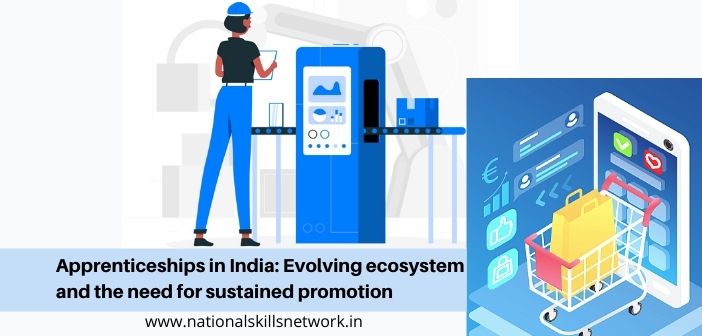
“Apprenticeship is one of the most efficient ways of developing the youth through on-the-job training and making them industry-ready”, says Ms. Veena Swarup, Former Director (HR), Engineers India Ltd (EIL). Students get to earn while they learn, discover their potential while gaining the real work experience.
Apprenticeships provide students with a structured training, while making one ready to take up any responsibility after they join an organisation. To understand more about the journey of apprenticeships in India and how it needs to be sustainably promoted to create awareness, we caught up with Ms. Veena Swarup. In this Skill Talk, we present excerpts from our conversation and the complete video interview is available on our YouTube.
Q: Where does India stand today in the journey of apprenticeship, especially after the launch of NAPS?
A: At the outset, I’d like to share my thoughts on apprenticeship. In public sector, all through, we have been implementing apprenticeship. As a HR professional in public sector, at each stage I saw that we had number of apprentices we recruited in ONGC each year, when I was in ONGC. And, they would finish their apprenticeship training and if there was a vacancy we would absorb them, otherwise they would move on to other jobs. So, it’s been there in all other companies, but somewhere in private sector, over the years, it was not that popular.
Let me tell you, Apprenticeship training is one of the best and most efficient ways of developing youth by on-the-job training and making them industry-ready. In fact, it is one of the most promising vehicles to promote skill development and training, on-the-job, in a real environment. In fact, ILO also says that apprenticeship is something that is very systematic, very structured and it needs to be related to the occupation.
Having said that, when there are so many good things about apprenticeship, why is it that it hasn’t taken-off? It’s been there in our country since 1961 as you would recall, over the years, there’ve been many amendments, but finally the National Apprenticeship Promotion Scheme (NAPS) bill was passed in 2014. And, then came the National Apprenticeship Training Scheme (NATS) in 2016. But, NAPS was also amended in 2016. So, though in the public sector it has been implemented, the percentage which has been kept as per the scheme is 2.5% to 10%, and in some companies they have even gone beyond 10%.
We were doing study of apprenticeship in India on the platform of FICCI, we realised that there are some large corporates who are very diligently implementing it; there are some smaller companies who are doing it, but there were a majority of companies, the SMEs and the MSMEs who are not even aware of it. Then, we spoke to some students, what we realized was the youth / students were not aware of it. Though a large number of good initiatives have come under these schemes, unfortunately, awareness in our country has not been that much that people really understand it.
Further, what has happened is there are number of schemes, if you look at NAPS, there are five types of apprentices.
Five types of apprentices under NAPS:
- Trade apprentices (8th, 10th, 12th class and even B.Sc)
- Graduate apprentices (Engineers and graduates)
- Technician apprentices (Diploma holders)
- Technical apprentices (10+2)
- Optional trade apprentices (5th class and above)
So, actually, it gives 5th class and above an opportunity for 6 months to 24 months of training with stipend. This is controlled and operated by MSDE. On the other hand, we have NATS, which is being implemented by MHRD, now the Ministry of Education.
Where NATS concerned, there is a stipend, 50% of the stipend is reimbursed to the organization by the government, and it is a one-year scheme, it’s been very well-implemented in many organizations. If I could speak about public sector, I was at EIL, we’ve been taking in apprentices every year. All our management trainees were taken in as apprentices for one year and then they are absorbed. I’m sure this is followed in many other companies and private corporate houses.
But, at the same time, there is a difference in the scheme under NAPS. There are three categories in industry:
- Large corporate houses who are doing lot of apprenticeship training, they have gone under their CSR budget, they have set up institutes, they are training and grooming them
- There are those companies who are not aware of it and not implementing at all
- Companies which are engaging apprentices but because of fear of compliance reports, they are not reporting it and at the same time they are using them in place of their regular workers
So, apprenticeship has not got the structure which it should in the country. A lot needs to be done from the point of view of advocacy, from the point view of awareness. How can we reach out to the students, to the organizations; there has to be some kind of a campaign in mission mode to go ahead and let everyone know what are the advantages of apprenticeship.

Q: How do we make apprenticeships as aspirational as internships among both the students and the parents?
A: This is a very important question. Apart from confusion about the apprenticeship schemes, there is total confusion between ‘trainees’, ‘interns’ and ‘apprentices’.
Internships are mostly promoted by AICTE. Internship is somehow getting mixed up with apprenticeship. Apprenticeship is on-the-job training and it is serious training. It has to follow a structure that has been laid down where actually, they are supposed to be signing a contract with the student and that compliance has to be given.
Whereas if you look at internship, it is not that serious business at all. It could be two months, six weeks or even four weeks. So, to mix up internship with apprenticeship would not be correct.
Parents are keen on internships, as it keeps their children busy utilising their time during summer vacation. It becomes aspirational for the students, as they get a peek into the what is happening inside the organisation. Interns are always kept at periphery and they are never taken into the organisation. They are never given hands-on training. They are asked to work on a project and complete it and then submit a report. Whatever maybe the quality of the report, most of the institutes pass it.
Whereas, if you look at apprenticeship, it is on-the-job training. In EIL we give them one year of rigorous training, where they are rotated from one department to the other. They are given the total insight. They are also sent to the construction sites. And, at the end of it, there is total turnaround of the students and they are ready to take up any responsibility.
In the NEP that has been announced, they have introduced credit system for apprenticeships. If it is properly propagated now, I’m sure it will be aspirational and people will take it up. Also, for the industries, we could think of incentivising them. Public sector is doing because it is a government company. But for the private sector, some are doing as a social responsibility, but, if we can somehow incentivise the industry, I am sure it would make a lot of difference.
Q: How can we address the issues of stipend and incentives not being enough?
A: If one-year training is happening, and the student is being given the opportunity to learn, and be able to make a career in that area, the amount of stipend should not be that important. The aspiration should not be derived from the amount of stipend, because it is the beginning of their journey and not the end of it. They should look at the career ahead and the emoluments.
There is another issue that is coming as a stumbling block and that is the infrastructure. ITIs have been the infrastructure in our country; they are not in a very good shape. Some of the big companies like Maruti, have adopted ITIs. Similarly, many other companies have taken up ITIs, adopted them, upgraded them and improved on their infrastructure for training, whereas, a majority of the ITIs are in very bad shape.
So, somewhere we need to encourage industry to come forward. And, that’s where I feel the government can throw up this idea to the industry, with some incentive, if they could adopt all the ITIs and improve on them.
The smaller companies don’t have the infrastructure, even if they have the knowledge. So, can we think of pooling of resources? Also, can larger companies train more apprentices and make them available for jobs in the smaller companies? Industry-wise, if this kind of collaborative effort can happen, I’m sure it will go a long way.
These are also the recommendations we have given in the FICCI report also and we are hopeful that gradually they will get implemented.
But at the heart of everything is the lack of data and that’s our number one recommendation in this report, where we say there should be a robust, single-point, seamlessly integrated, transaction-based data system. We have called it as Education to Employment stack (E2E). Here, we are suggesting that from the time the student is at high school level, through apprenticeship, through their higher education, skilling, we need to bring in career guidance also and then employment. From the other side, industry will bring in the avenues and jobs that are available. If we could have this kind of a database and it should be built up on Aadhar platform, as a national level database. This is one of our recommendations.
Today, we don’t even know how many students are school dropouts, so that they can be nudged, they can be nurtured, can be brought on to this track and career guidance can be given to them. FICCI is also setting up a center for career guidance and career counselling.
Let me share with you the China model. They have a single ministry, it’s called the Ministry of Human Resource and Social Security. It takes care of primary education, apprenticeship, vocational training, career counselling and then to the employment. This kind of collaborative effort is necessary.
Another big harm I see is individual portals have been set up and each portal doesn’t speak to the other. So, where is the data going? These are certain things that need to be streamlined and a real massive communication drive needs to happen.
Related Article: How to make apprenticeships more attractive to enterprises and SMEs – Read more: https://nationalskillsnetwork.in/how-to-make-apprenticeships-more-attractive-to-enterprises-and-smes/
Q: What are the steps that need to be taken to create the mass level awareness?
A: First, there should be total communication drive on apprenticeship on all media channels, television channels, social media, and also in the speeches given by our leaders. The communication has to be impactful to reach out to the grassroots level.
Second, apprenticeships should start at the school level. The students should be exposed to trades like plumbing and carpentry and understand the advantages that come with it and appreciate it.
The industry bodies need to take it up and convey the importance. I would reiterate the need for incentivisation of the industry to implement apprenticeships and promote them among different stakeholders.





Comments 1